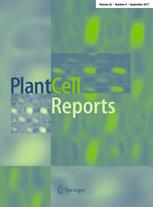Ver ítem
- xmlui.general.dspace_homeCentros e Institutos de InvestigaciónCICVyA. Centro de Investigación en Ciencias Veterinarias y AgronómicasInstituto de BiotecnologíaArtículos científicosxmlui.ArtifactBrowser.ItemViewer.trail
- Inicio
- Centros e Institutos de Investigación
- CICVyA. Centro de Investigación en Ciencias Veterinarias y Agronómicas
- Instituto de Biotecnología
- Artículos científicos
- Ver ítem
Genomic re-assessment of the transposable element landscape of the potato genome
Resumen
Transposable elements (TEs) are DNA sequences with the ability to autoreplicate and move throughout the host genome. TEs are major drivers in stress response and genome evolution. Given their significance, the development of clear and efficient TE annotation pipelines has become essential for many species. The latest de novo TE discovery tools, along with available TEs from Repbase and sRNA-seq data, allowed us to perform a reliable potato TEs detection,
[ver mas...]
Transposable elements (TEs) are DNA sequences with the ability to autoreplicate and move throughout the host genome. TEs are major drivers in stress response and genome evolution. Given their significance, the development of clear and efficient TE annotation pipelines has become essential for many species. The latest de novo TE discovery tools, along with available TEs from Repbase and sRNA-seq data, allowed us to perform a reliable potato TEs detection, classification and annotation through an open-source and freely available pipeline (https://github.com/DiegoZavallo/TE_Discovery). Using a variety of tools, approaches and rules, we were able to provide a clearly annotated of characterized TEs landscape. Additionally, we described the distribution of the different types of TEs across the genome, where LTRs and MITEs present a clear clustering pattern in pericentromeric and subtelomeric/telomeric regions respectively. Finally, we analyzed the insertion age and distribution of LTR retrotransposon families which display a distinct pattern between the two major superfamilies. While older Gypsy elements concentrated around heterochromatic regions, younger Copia elements located predominantly on euchromatic regions. Overall, we delivered not only a reliable, ready-to-use potato TE annotation files, but also all the necessary steps to perform de novo detection for other species.
[Cerrar]

Autor
Zavallo, Diego;
Crescente, Juan Manuel;
Gantuz, Magdalena;
Leone, Melisa;
Vanzetti, Leonardo Sebastian;
Masuelli, Ricardo Williams;
Asurmendi, Sebastian;
Fuente
Plant Cell Reports 39 : 1161–1174 (2020)
Fecha
2020-05
Editorial
Springer
ISSN
0721-7714
1432-203X
1432-203X
Formato
pdf
Tipo de documento
artículo
Palabras Claves
Derechos de acceso
Restringido
 Excepto donde se diga explicitamente, este item se publica bajo la siguiente descripción: Creative Commons Attribution-NonCommercial-ShareAlike 2.5 Unported (CC BY-NC-SA 2.5)
Excepto donde se diga explicitamente, este item se publica bajo la siguiente descripción: Creative Commons Attribution-NonCommercial-ShareAlike 2.5 Unported (CC BY-NC-SA 2.5)

